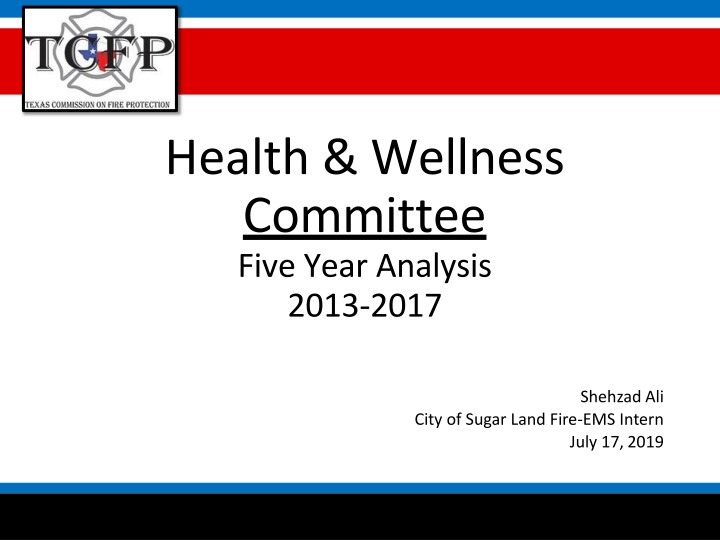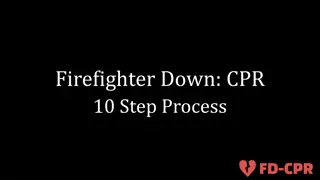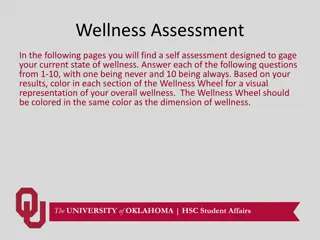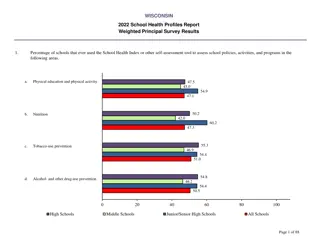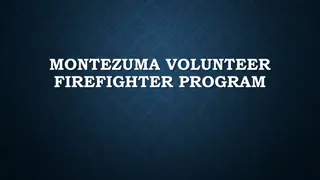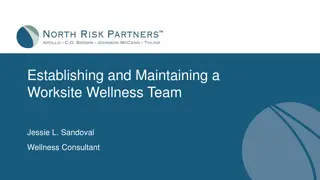Analysis of Firefighter Health and Wellness Trends Over Five Years
Firefighter Health and Wellness Committee's analysis from 2013-2017 reveals concerning trends in strains and sprains, age-injury correlation, types of injuries, and emergency vs. non-emergency activities. The data highlights the need for targeted strategies to improve firefighter well-being and reduce injuries.
Download Presentation

Please find below an Image/Link to download the presentation.
The content on the website is provided AS IS for your information and personal use only. It may not be sold, licensed, or shared on other websites without obtaining consent from the author.If you encounter any issues during the download, it is possible that the publisher has removed the file from their server.
You are allowed to download the files provided on this website for personal or commercial use, subject to the condition that they are used lawfully. All files are the property of their respective owners.
The content on the website is provided AS IS for your information and personal use only. It may not be sold, licensed, or shared on other websites without obtaining consent from the author.
E N D
Presentation Transcript
Health & Wellness Committee Five Year Analysis 2013-2017 Shehzad Ali City of Sugar Land Fire-EMS Intern July 17,2019
Firefighter Health and Wellness The mission of the Firefighter Health and Wellness Committee is to provide factual data and practical guidance regarding key areas of health and wellness to educate and facilitate the development of action guides by individuals and departments.
n Firefighter Health a d Wellness Commissioner Mala Sharma Chair Daniel DeYear Dallas Fire Rescue Scott Thompson- The Colony Fire Department Christopher Kahl Portland Fire Department Danny Kistner McKinney Fire Brett Ellis Harris County ESD #48 Michael Mire Houston Fire Department Steven Green Longview Fire Department. Doug Boeker Sugar Land Fire Department Dr. Sara Jahnke Center for Fire, Rescue & EMS Health Research Dr. Lucas Garcia - McAllen Fire Department Homer Javier Salinas Mission Fire Department
Strains and Sprains There is an average of 1,896 strains- sprains per year. In the last five years strains-sprains have made up 47.4% of the number of total injuries. There was an average of 536 Firefighters a year who missed time with a strain-sprains. Since 2015 Firefighters who have missed time with a sprain-strain injury were out an average of 46 days.
Injuries by Types of Activity There is an average of 774 Firefighters who take time off because of an injury. Each year there is an average of 28,588 days missed due to injury. Equivalent to - 686,112 hours missed - 238 full time Firefighters off for a year
Emergency Vs Non-Emergency List of Emergency Activities (Percentage of Total Injuries) EMS (26.38%) Fire Suppression (22.44%) Rescue-Non Fire (6.15%) Responding to Incidents (3.80%) Rescue- Fire Related (1.12%) Returning from Incidents (1.43%) Hazmat (0.67%) List of Non-Emergency Activities (Percentage of Total Injuries) Station Duties (15.67%) Skills Training (10.79%) Wellness/Fitness (9.96%) Fire Prevention (1.58%)
Texas vs National Note: NFPA uses data from big and small cities but the report uses 2,592 departments to make a projection for total number of injuries in the United States. Source: BLS Statistics, Texas A&M Forrest Service, NFPA
- Fireground includes Fire Suppression and Rescue-Fire Related - Non-Fire includes Rescue Non-Fire, EMS, and Hazmat - Other On-Duty includes Fire Prevention, Station Duties, and Wellness/Fitness - Responding and Returning and Training appear to correspond closely to the commission s categories
Exposures The number of undetermined exposure routes have gone up 422% the last five years. The number of unknown exposure descriptions have gone up 566% the last five years.
Firefighter Health and Wellness Routes of exposure: Absorption: Modern fires are more like hazardous materials incidents. Approximately 84,000 chemicals are used in modern construction and contents. Prolonged dermal exposure to soot. Contaminants may adhere to personal protective equipment. Absorption increases 400% with each 5 increase in skin temperature. Neck area is one of most common areas for exposure, angle of the jaw, and forehead. Be Quick. Be Smart. Protect your head. Source: March 2019 Health and Wellness Presentation
Cancer Report Firefighter occupational cancer is reported voluntarily. 10 reports of firefighter cancer reported to TCFP in 2017. 14 reports of firefighter cancer reported to TCFP in 2016. Note: several Texas Fire Departments anecdotally report much higher incidence of cancer.
Firefighter Health and Wellness Cancer Type Testicular Mesothelioma Multiple Myeloma Non-Hodgkins Lymphoma Skin Brain Malignant Melanoma Prostate Colon Lukemia Risk Scope: 2.02 (x) greater risk 2.0 (x) greater risk 1.53 (x) greater risk 1.51 (x) greater risk 1.39 (x) greater risk 1.31 (x) greater risk 1.31 (x) greater risk 1.28 (x) greater risk 1.21 (x) greater risk 1.14 (x) greater risk Source: March 2019 Health and Wellness Presentation
Firefighter Health and Wellness Scope: According to data collected by IAFF, Cancer has caused 61% of career firefighter Line of Duty Deaths since 2002. Firefighters have a 9% higher risk of cancer diagnosis than the general population. Firefighters are 14% more likely to die from cancer than the general population. Estimates that 1/3 of all firefighters will experience cancer at some point in their lives. Respiratory, digestive, and urinary cancer prevalent. Mesothelioma among firefighters is double the reported rate for the general population. Source: March 2019 Health and Wellness Presentation
Problems with Data Collection We need to ask better questions when collecting exposure information. Exposures make up 24.38% of total injuries but we do not gather enough data about the actual exposures. We need to do a better job of reporting cancer data. Move toward mandatory cancer reporting. Injury Illness Statistics Average of 47 injury reports concerning chest pains-cardiac.
Recommendations Recommendations Based on their review of the data contained within this report, the commission offers the following recommendations to the Texas fire service: Improve awareness and distribution of the annual injury report by notifying fire department administrators when this and future reports are published and provide a link to the report in the notifications. Enhance program features and usability by providing better explanations, descriptions and definitions of terms in both the reporting module and in the annual report. Provide the Texas fire service with injury updates, perhaps on a quarterly basis, targeting trends or other issues noted during the year. This could be accomplished via postings on the agency s website, social media platforms, or by other means. Explore options for incorporating injury data into annual continuing education opportunities for fire personnel.
Recommendations(cont.) Strains-Sprains Stretching EMS equipment review / Patient moving Equipment deployment / Apparatus design Weightlifting Review purpose of weight lifting Review types of exercise routines
Recommendations(cont.) Cancer Consider early detection testing Review Health & Wellness Committee Mar 2019 presentation Read The Lavender Report Clean everything often Fire ground Injury Prevention Fire Risk Analysis Familiarity walk through Pre-planning
